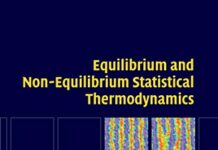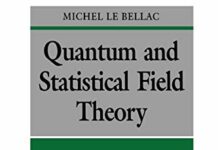
Ebook Info
- Published: 2011
- Number of pages: 606 pages
- Format: PDF
- File Size: 2.98 MB
- Authors: Michel Le Bellac
Description
Quantum physics allows us to understand the nature of the physical phenomena which govern the behavior of solids, semi-conductors, lasers, atoms, nuclei, subnuclear particles and light. In Quantum Physics, Le Bellac provides a thoroughly modern approach to this fundamental theory. Throughout the book, Le Bellac teaches the fundamentals of quantum physics using an original approach which relies primarily on an algebraic treatment and on the systematic use of symmetry principles. In addition to the standard topics such as one-dimensional potentials, angular momentum and scattering theory, the reader is introduced to more recent developments at an early stage. These include a detailed account of entangled states and their applications, the optical Bloch equations, the theory of laser cooling and of magneto-optical traps, vacuum Rabi oscillations and an introduction to open quantum systems. This is a textbook for a modern course on quantum physics, written for advanced undergraduate and graduate students.
User’s Reviews
Reviews from Amazon users which were colected at the time this book was published on the website:
⭐Let me start off by saying that this textbook is not meant for undergraduates who are starting to learn QM. Instead, as the textbook stated on the back, this is a textbook “written for advanced undergraduate and graduate students.” So if you are new to QM, stay away!First complaint is that the author does not clearly explain anything. Unless you have prior knowledge of the material (which I didn’t) then it is nearly impossible to keep up with the author. I didn’t realize that the author was describing the Stern-Gerlach experiment until I saw the picture because it was so confusing! The author used a lot of math but does not provide the necessary explanations.Second complaint is how the chapters are organize. Normally a QM textbook covers most of the mathematical concepts in the beginning and then focuses on the spin, angular momentum, and etc later on. In this textbook, I was reading about Quantum Chemistry and Nuclear Magnetic Resonance in chapter 5 and 6! What made it even worse is that the author was using all this math to explain the concepts! Then the author returns to discuss the mathematical concepts in chapter 7!Third complaint are the errors in the textbook, especially in the homework problems! Even my professor and the rest of my classmates noticed the errors. Kind of frustrating when you are doing the correct calculations but do not get the same answer as the textbook.Overall, stay away from this textbook. Quantum Mechanics is a tough subject and I didn’t learn anything from this textbook. Instead I had to wiki almost all the topics and use other textbooks to gain better insight. Then I was able to go back and reread the chapters to have SOME idea of what is going on.
⭐This book can join the ranks of books such as Quantum Mechanics: New Approaches To Selected Topics (Lipkin), Lectures On Quantum Mechanics (Baym) and Cohen-Tannoudji’s Quantum Mechanics. That is, a text that is valuable to both undergraduate and graduate-level students alike. Happily, as with any topic, this textbook offers much that is neglected in those expositions (caveat: you will not find mention of path integrals). So, what do we find ?(1) First and foremost are the problems ! This text is an outstanding opportunity in assisting with solving problems. Not confident with your dimensional analysis skills ? Then, problems 1-6, page 33 will help you with that ! An excellent beginning. A favorite exercise, pages 35-37, neutron diffraction: I implore the prospective student to glance at this multi-pronged approach. For more dimensional analysis, peruse the exercises in the book Quantics, by Levy-Leblond/Balibar.(2) Chapter one is introductory (probability amplitudes, linear superposition). Chapter two, mathematical. Not all is completed in only one sitting, as chapter seven continues this theme with infinite dimensional spaces. Finite dimensional Hilbert space is amplified in twenty-pages. A problem in beam-splitters will conclude (page 59).(3) A concentration on “two-dimensional spaces” occupies chapter three. Photons first, electrons next.The first part concludes with a brief on quantum cryptography. The chapter concludes with neutrons (again): “Let us re-visit the experiment described in problem #1.6.4 on neutron diffraction by a crystal.” (page 94). This is a clue to the pedagogy employed: You will approach the same topic stepwise, at first in elementary manner (qualitative), then from a more advanced viewpoint (abstract). Problems in a previous chapter revisited later. Excellent methodology !(4) From polarization (third chapter) to postulates (fourth chapter). Now, read: “measurement in quantum mechanics is different from that in classical physics; in classical physics, a measurement reveals a pre-existing property” (page 104). Re-visit more of these measurement issues in section #6.4.1: “measurement and decoherence” (page 185). I reiterate: Topics are presented more than once throughout the exposition (this is termed a “spiral” approach to the material).(5) Applications of those postulates are detailed in the following chapter. This is a highlight of the text: Ethylene molecule, Benzene molecule, nuclear magnetic resonance, Ammonia molecule, Ammonia maser, the two-level atom (these topics will consume pages 125-150. Beautiful material.(6) Now begins two-particle states and entanglement (page 158). Another postulate (5) is introduced. Density Operators introduced. EPR and Bell’s Inequalities introduced. Read: “rather than nonlocality, it is preferable to speak of non-separability of the state vector.” (page 179). I wholeheartedly agree with that comment ! The chapter concludes with a brief on quantum information (pages 191-198). End-of-chapter problems–as usual–are instructive.(7) Mathematical interlude, up next (infinite-dimensional Hilbert spaces). Ten pages, a bit of abstraction. Reading: “following physicist’s practice, we shall no longer distinguish between Hermitian and self-adjoint and only speak of Hermitian operators.” (page 216). Three problems here are straightforward (page 221).(8) Symmetries come later than is now fashionable (page 222). Reference to Weinberg: Quantum Fields.(9) Wave mechanics and Schrodinger come late, in chapter nine. Read: “…used to describe one particle in three-dimensional space” and “choosing a basis in which the position operator is diagonal.” (page 250). Repeat those words again and again ! Chapter nine (250 pages) is a mini-course utilizing Schrodinger’s wave equation. You meet again measurement theory (page 304) in a three-part problem set (#9.7.14). That is, Von Neumann is introduced.(10) You get more Angular Momentum (chapter 10) which you were introduced to previously (chapter 8) ! Here, it is more quantitative. A section on angular momentum in decays is nice (page 331). A multipart problem continues that theme: “production and decay of the rho-positive meson” (page 354). Nice !(11) Harmonic Oscillator, presented later than is fashionable these days (chapter eleven). An introduction to coherent states (page 364) and quantized fields (page 367) is exemplary. As my review is running long, I will only touch upon the remainder of the text: scattering theory (Merzbacher is referenced), Bosons and Fermions along with spin and statistics (beam-splitters again: problem on page 452), one-electron atoms (chapter fourteen) with a lucid discussion of laser manipulation of atoms (see pages 479-493). Neutrons appear once again in a concluding problem: “radiative capture of neutrons by hydrogen” (page 504).(12) Final chapter surveys Open Quantum Systems (the previous chapters were closed systems). This is a wonderful introduction to this topic, borrowing from Preskill’s Lectures on Quantum Computation.The final problem of the text involves quantum Brownian motion and Wigner’s functions (page 550).(13) In conclusion: A fine textbook. The initial ten chapters appeal to a basic course for undergraduates, the final chapters appeal to graduate students (as a variety of approaches are referred to in the preface). Above all: A fantastic opportunity to approach problems from a different point of view.Also, a fun book to merely read and digest.
⭐Don’t be fooled by the title, this is NOT an introduction to quantum mechanics.This book is a valuable resource for those who have attended all undergraduate quantum theory courses. It is complete and rigorous and the important ideas are clearly highlighted.If you are a starting graduate looking for a single book on quantum theory then ignore the poor reviews and get this book, you won’t regret it!SB
⭐Enjoyed the book while crossreading other QM books. Nice mathematical introduction.Especially a good chapter on measurement, finite, infinite Hilbert Space, unbound and bound operators
⭐Unfortunately, I had to use this book for a whole year. This book just plain stinks! The author is long winded and waste alot of space doing trivial things. Often, he leaves the more important topics as homework exercises. The explanations he does give are so confusing you’ll have to read another book just to know what’s going on. If you want a good Quantum Mechanics book, I suggest Sakurai.
⭐I don’t know this book and have only just started to plough through it in an attempt yet again to try to understand the finer points of QM which I didn’t get when at university!! I like the modern approach to teaching QM at this senior/post grad level though I wish this author would explain just a bit more of the maths – I’ve noticed he tends to skip explanations in one or two places by referring you to another book (eg Byron et al -which I have, fortunately) I prefer textbooks (because this is what this book really is) to be more or less self contained with explanatory appendices etc where necessary but I suppose that in this day and age, more than ever, cost comes into the frame
⭐Esami
Keywords
Free Download Quantum Physics in PDF format
Quantum Physics PDF Free Download
Download Quantum Physics 2011 PDF Free
Quantum Physics 2011 PDF Free Download
Download Quantum Physics PDF
Free Download Ebook Quantum Physics



